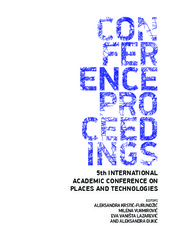| dc.creator | Miletić, Mirjana | |
| dc.creator | Krstić-Furundzić, Aleksandra | |
| dc.date.accessioned | 2020-04-30T19:45:21Z | |
| dc.date.available | 2020-04-30T19:45:21Z | |
| dc.date.issued | 2018 | |
| dc.identifier.isbn | 978-86-7924-199-3 | |
| dc.identifier.uri | https://raf.arh.bg.ac.rs/handle/123456789/642 | |
| dc.description.abstract | Statistics show that about 8% of overall EU building sector belongs to Sports and Recreation
Building Stock, that represents about one and a half million of these kinds of buildings. It’s been
estimated that out of whole building sector these public buildings are accounting up to 10% of
total annual energy consumption. Considering that in 2008 overall energy use was about 1,768
[Mtoe], there is the potential to reduce energy consumption of about 21 [Mtoe] on a yearly base
in the EU Sport Facility Building Stock which is far away of insignificant (SportE2, 2018).
Most of the buildings of this kind were built from 1960 to 1980. At the time of construction,
energy efficiency was not taken into consideration, and even if it was taken into account, the
equipment and fabrics installed at that time are not efficient now as at the time of installation.
Energy sources are mostly traditional, fossil fuel based. Since regulations on energy efficiency
are more stringent, these facilities must be renovated and then well maintained in terms of
energy consumption. Sport buildings are mostly very well postured to adopt RES technologies,
as active features, having in mind large open spaces and large outdoor surfaces. However, this
paper investigates use of Passive House technologies in these manmade structures that may
be productive in energy saving. The case study includes sport centre built in 1974 in Belgrade,
Serbia. Different Passive House measures applied on the building structure and benefits in the
sense of reducing total annual energy consumption for space heating, as well as conditions
related to the comfort of the indoor environment were simulated in software package Integrated
Environmental Solutions Virtual Environment, IES VE 2016, that is approved by USGBC,
ASHRAE, CIBSE and U.S. Department of Energy. | en |
| dc.language.iso | en | sr |
| dc.publisher | Belgrade : University, Faculty of Architecture | sr |
| dc.relation | info:eu-repo/grantAgreement/MESTD/Technological Development (TD or TR)/36035/RS// | sr |
| dc.rights | openAccess | sr |
| dc.source | Conference Proceedings [Elektronski izvor] / 5th international Academic Conference on Places and Technologies, [Belgrade] | sr |
| dc.subject | Public buildings | sr |
| dc.subject | Sport facilities | sr |
| dc.subject | Belgrade | sr |
| dc.subject | Energy refurbishment | sr |
| dc.subject | Passive House technologies | sr |
| dc.title | Energy refurbishment of a public building in Belgrade | en |
| dc.type | conferenceObject | sr |
| dc.rights.license | ARR | sr |
| dcterms.abstract | Крстић-Фурундзић, Aлександра; Милетић, Мирјана; | |
| dc.citation.spage | 348 | |
| dc.citation.epage | 356 | |
| dc.identifier.fulltext | https://raf.arh.bg.ac.rs/bitstream/id/1712/PT2018KrsticA.pdf | |
| dc.identifier.rcub | https://hdl.handle.net/21.15107/rcub_raf_642 | |
| dc.type.version | publishedVersion | sr |

